Physical Address
304 North Cardinal St.
Dorchester Center, MA 02124
Deformities and diseases of the toenails are some of the most common and most disabling foot problems. They range from minor annoyances to severe life- or limb-threatening conditions, and abnormalities of the toenails can be a sign of a systemic disease process. Often the pain associated with nail disorders has a marked effect on individuals’ daily lives. A study of 55 patients with nail disorders found that they were significantly correlated with dysfunction of the lower extremities and, in elderly patients, were likely to increase the risk of falling. Many of the specific nail pathologies and associated systemic disorders are outside the scope of orthopaedic medicine, but awareness and basic understanding are important for any clinician encountering foot and ankle conditions. This chapter briefly highlights nail pathology associated with systemic diseases, tumors, acquired disorders, and surgical techniques.
The normal nail complex consists of the nail plate, the nail bed, and the surrounding skin. The nail plate is the nail proper and consists of two components: the root, the portion of the nail plate that is beneath the skin, and the body, the exposed portion of the nail plate. The nail plate is made up of overlapping layers of keratinized cells. Beneath the nail plate, the nail bed has two components, the sterile matrix and the germinal matrix. This distal margin of the germinal matrix can be seen through the nail plate as pale, crescent-shaped tissue at the base of the nail plate. This visible portion of the germinal matrix is termed the lunula . From the distal margin of the lunula, the germinal matrix extends 5to 8 mm proximally and deep to the proximal nail fold. The germinal matrix is smoother and paler than the adjacent sterile matrix, and it contributes to longitudinal nail plate growth ( Fig. 88.1A ). Distal to the germinal matrix, the sterile matrix supplies a vascular bed for the nail plate. The margins of skin that overhang the lateral borders of the nail are termed lateral nail folds . The proximal nail fold is termed the eponychium , and its distal extension that covers the nail root and adheres to the nail plate is the cuticle . Finally, the hyponychium is the thickened skin located at the distal margin of the nail.
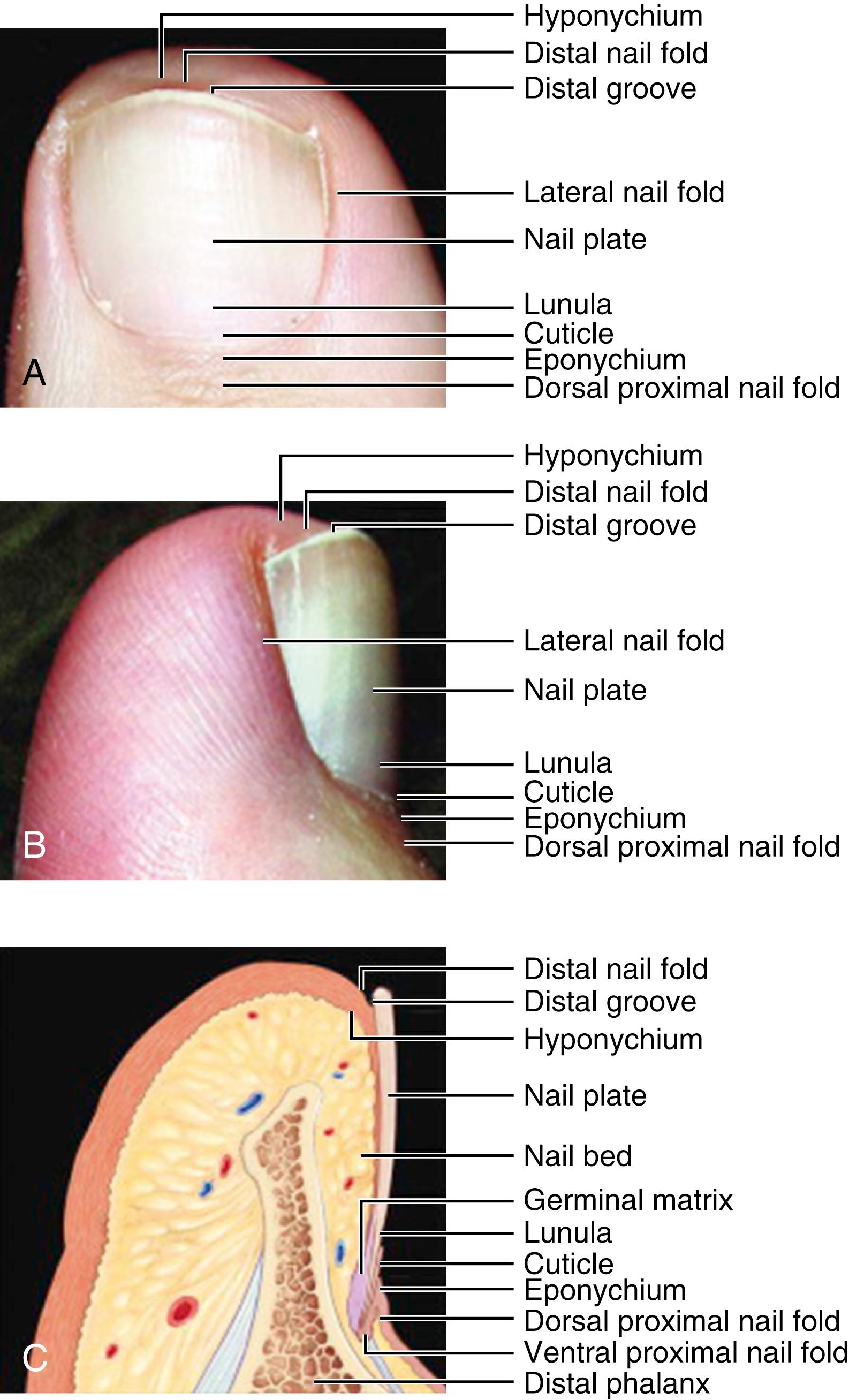
Many descriptive terms and definitions communicate nail pathologies ( Box 88.1 ). Although not always realized, nail pathology may be a sign of other underlying pathology. Many systemic diseases are associated with nail abnormalities ( Table 88.1 ).
Acral: Of or belonging to the extremities of peripheral body parts.
Anonychia: Absence of nails. When anonychia is congenital, all the nails are usually absent and the condition is permanent. It can occur temporarily from trauma, systemic or local disease. Also seen in nail-patella syndrome.
Beau lines: Transverse lines or ridges marking repeated disturbances of nail growth. May be associated with trauma or a systemic disease process.
Clubbing: Hypertrophied, curved nail with flattened angle between the nail plate and proximal fold. Associated with chronic pulmonary and cardiac disease.
Hapalonychia: Extremely soft nails that may be prone to splitting; associated with endocrine disturbances, malnutrition, and contact with strong alkali solutions.
Hemorrhage: Bleeding. Beneath toenail, bleeding may be associated with vitamin C deficiency, subacute bacterial endocarditis, and dermatologic disorders. Subungual hematoma occurs after trauma to toenail bed.
Hutchinson sign: Hyperpigmentation spreading from nail to surrounding soft tissue. Pathognomonic for melanoma.
Hyperkeratosis: Thickening of the stratum corneum layer of the epidermis.
Hyperkeratosis subungualis: Hypertrophy of the nail bed. May be associated with onychomycosis, psoriasis, and other dermatologic disorders.
Koilonychia: Concavity of the nail plate in both longitudinal and transverse axes. Associated with nutritional disorders, iron deficiency anemia, and endocrine disorders.
Lentigo: A small melanotic spot without pigment, which is potentially malignant and is unrelated to sun exposure.
Leukonychia: White spots or striations in the nail resulting from trauma and systemic diseases, such as nutritional and endocrine deficiencies.
Mees lines: Horizontal striations 1 to 3 mm wide associated with growth arrest.
Melanonychia: A longitudinal streak of pigment visible in or beneath the nail.
Onychauxis: Greatly thickened nail plate caused by persistent mild trauma and onychomycosis.
Onychia: Inflammation of the nail matrix, causing deformity of the nail plate and resulting from trauma, infection, and systemic diseases, such as exanthemas.
Onychitis: Inflammation of the nail.
Onychoclasis: Breakage of the nail plate.
Onychocryptosis: Ingrowing of nails or, more specifically, hypertrophy of the nail lateral fold; also referred to as hypertrophied ungual labia or unguis incarnatus ; one of the most common pathologic conditions of the toenail.
Onychogryphosis: “Claw nail” or “ram’s horn nail”; extreme hypertrophy of the nail gives the appearance of a claw or horn. May be congenital or a symptom of many chronic systemic diseases, such as tinea infections. See onychauxis.
Onycholysis: Loosening of the nail plate, beginning along the distal or free edge when trauma, injury by chemical agents, or diseases loosen the nail plate. Associated with psoriasis, onychomycosis, acute fevers, and syphilis.
Onychoma: Tumor of the nail unit.
Onychomadesis: Complete loss of the nail plate.
Onychomalacia: Softening of the nail.
Onychomycosis: Fungal infection of the nail associated with fungal disease of the foot.
Onychophosis: Accumulation of callus within the lateral groove, involving the great toe more often than the lesser toes.
Onychoptosis defluvium: Nail shedding.
Onychorrhexis: Longitudinal ridging and splitting of nails caused by dermatoses, nail infections, systemic diseases, senility, or injury by chemical agents.
Onychoschizia: Lamination and scaling away of nails in thin layers caused by dermatoses, syphilis, or chemical agents.
Onychosis: Disease or deformity of the nail plate. Also called onychopathy.
Onychotrophia: Atrophy or failure of development of a nail caused by trauma, infection, endocrine dysfunction, or systemic disease.
Orthonyx: Mechanical bracing of nails to correct curvature.
Pachyonychia: Extreme thickening of all the nails. Thickening is more solid and more regular than in onychogryphosis. Usually, a congenital condition associated with hyperkeratosis of the palms and soles.
Paronychia: Inflammation of soft tissues around the nail margin, which can occur after trauma or infection (bacterial or fungal).
Parrot beak nail: Hooked nail deformity where nail curves palmarward. May be caused by tight closure of a digit tip amputation.
Pincer nail: Ingrown toenail with both sides of the nail turned in, nearly forming a complete circle.
Pitting: Tiny depressions in the nail surface; associated with psoriasis and alopecia areata. Also known as “stippling.”
Pterygium: Growth of cuticle distal to the nail plate, splitting the nail into two or more portions that gradually decrease in size as the growth widens. Can result from trauma and decreased circulation in the toes.
Stratum corneum: The most superficial layer of the epidermis.
Subungual hematoma: Blood that has collected beneath the nail plate, usually secondary to trauma. Also known as “tennis toe” or “jogger’s toe.”
Trachyonychia: “Rough nails.” A reaction or morphologic pattern, with various clinical appearances and causes.
Yellow nail syndrome: Keratohyalin granules within the nail plate seen only with electron microscopy.
| Disease | Pathologic Changes |
|---|---|
| Arterial emboli | Splinter hemorrhages |
| Arteriosclerosis obliterans | Leukonychia partialis |
| Bacterial endocarditis | Clubbing, splinter hemorrhages |
| Hypertension | Splinter hemorrhages |
| Ischemia | Onycholysis, pterygium |
| Mitral stenosis | Splinter hemorrhages |
| Myocardial infarction | Mees lines, yellow nail syndrome |
| Vasculitis | Splinter hemorrhages |
The dropping of heavy objects or activities performed without wearing shoes can cause traumatic injuries that can easily damage the nail plate, nail bed, and underlying phalanx. These injuries can cause long-term nail plate abnormalities and even nail plate loss. Abnormalities can include ridging, splitting, thickening, and discoloration. Treatment goals for nail bed and plate injuries include repairing the nail bed and maintenance of the eponychial fold to minimize future nail deformity. The sterile matrix is very vascular; hence, subungual hematomas frequently occur with trauma. Treatment of subungual hematomas remains controversial. Past recommendations have included nail plate removal for nail bed exploration and repair for subungual hematomas larger than 50% of the size of the nail or larger than 25% with an underlying fracture. More recently, others have suggested trephination alone is adequate treatment when nail margins are intact.
When nail margins are intact, we typically treat subungual hematomas with trephination or observation depending on the patient’s pain and acuity. Trephination can be done by using a heated paperclip to perforate the nail plate. The hematoma cools the paper clip, preventing nail bed injury. Other methods include ophthalmic cautery or needle perforation. Occasionally, more than one opening is required to adequately maintain hematoma decompression.
Despite the controversy, most authors agree that if a subungual hematoma is associated with unstable nail margins, then nail plate removal, exploration, and nail bed repair is indicated to prevent future aesthetic and functional problems. Laceration repairs should be completed with small absorbable suture (7-0 chromic) or medical adhesives (2-octyl cyanoacrylate). After repairing the nail bed, the nail or an alternative material (acrylic nail, aluminum foil, silicon sheeting, or other nonadherent material) should be secured over the nail bed and under the eponychium, preventing adhesions between the eponychium and the germinal matrix. Creating small perforations in the replaced nail or other material is important to prevent fluid accumulation beneath the nail. The nail can be secured with a figure-of-eight stitch or medical adhesive ( Fig. 88.2 ).
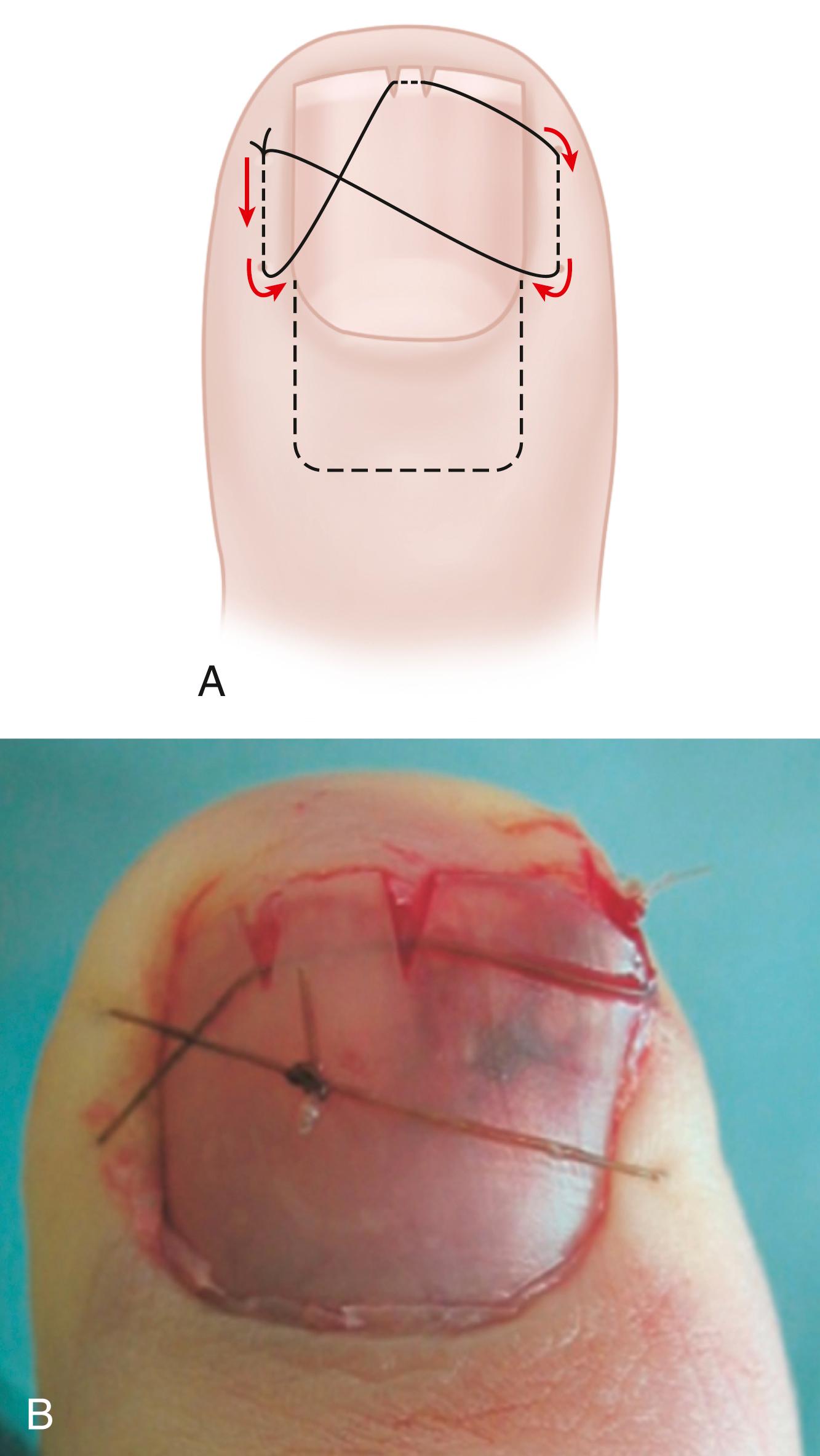
Deformed nails in elderly and diabetic patients can be difficult to manage at best and catastrophic at worst, especially when associated with an insensitive foot. Having a small double-action rongeur and nail splitter-cutter in the office is recommended. These nails can be reduced quickly and safely with these instruments ( Fig. 88.3 ).
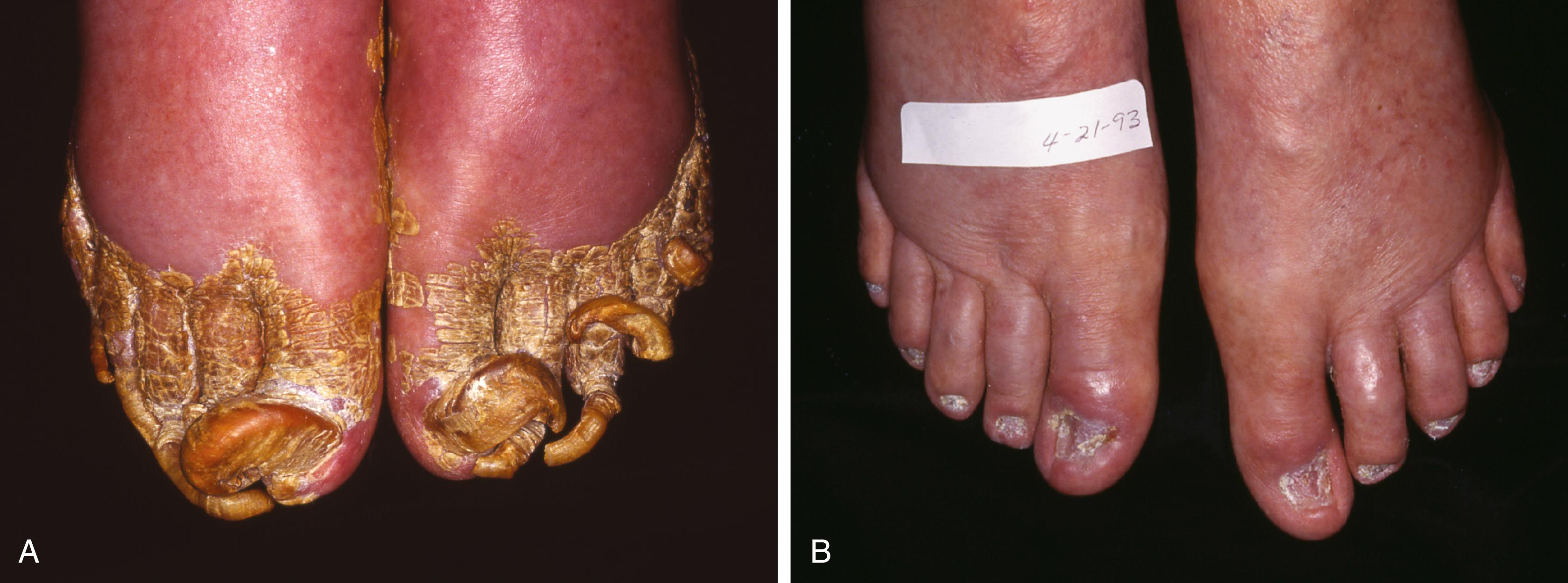
Other than reduction of the nail mass, onychomycosis, or fungal infection of the nails, can often be treated with benign neglect because its main effect is a cosmetic one. If treatment is desired to eradicate the fungal infection, referral to a dermatologist may be warranted for confirmatory testing through appropriate cultures followed by cost-effective medical treatment, either by topical or oral agents. Most treatment regimens are prolonged because it is difficult for various medications to penetrate the nail. Many of the oral medications have serious side effects, and patients should be appropriately monitored for these side effects.
The efficacy of laser therapy for onychomycosis remains controversial. Lasers are approved by the US Food and Drug Administration (FDA) for “temporary increase of clear nail in patients with onychomycosis,” but laser treatment has resulted in lower cure rates than oral and topical therapies. Hence, laser treatment is not regarded as a first line treatment for onychomycosis.
This entity is not a primary nail abnormality; however, it is usually presented as a painful and deformed nail, leaving the examiner perplexed as to the cause of the pain and deformity ( Fig. 88.4 ). The exostosis of the distal phalanx is formed from fibrous tissue and has a fibrocartilage cap, as opposed to an osteochondroma, which is formed from enchondral ossification and has a hyaline cartilage cap. The chromosomal translocation t(X:6)(q22;q13-14) is linked to this entity, suggesting a neoplastic origin. Routine radiographs of the feet may not show the exostosis because the technique does not emphasize the distal phalanx. Radiographs taken at oblique angles and magnified are helpful. Conservative treatment is not usually successful as this lesion is progressive, and surgical excision is the treatment of choice. If the exostosis has not disrupted the nail bed, the incision should be made lateral or medial to the nail bed, elevating it off the exostosis to remove it to preserve the nail bed ( Fig. 88.4 ). If, however, the nail bed is disrupted, a dorsal incision to remove the exostosis should be used ( Fig. 88.5 ). The most common complication from surgical excision is nail deformity. Recurrence has been reported at 4%.

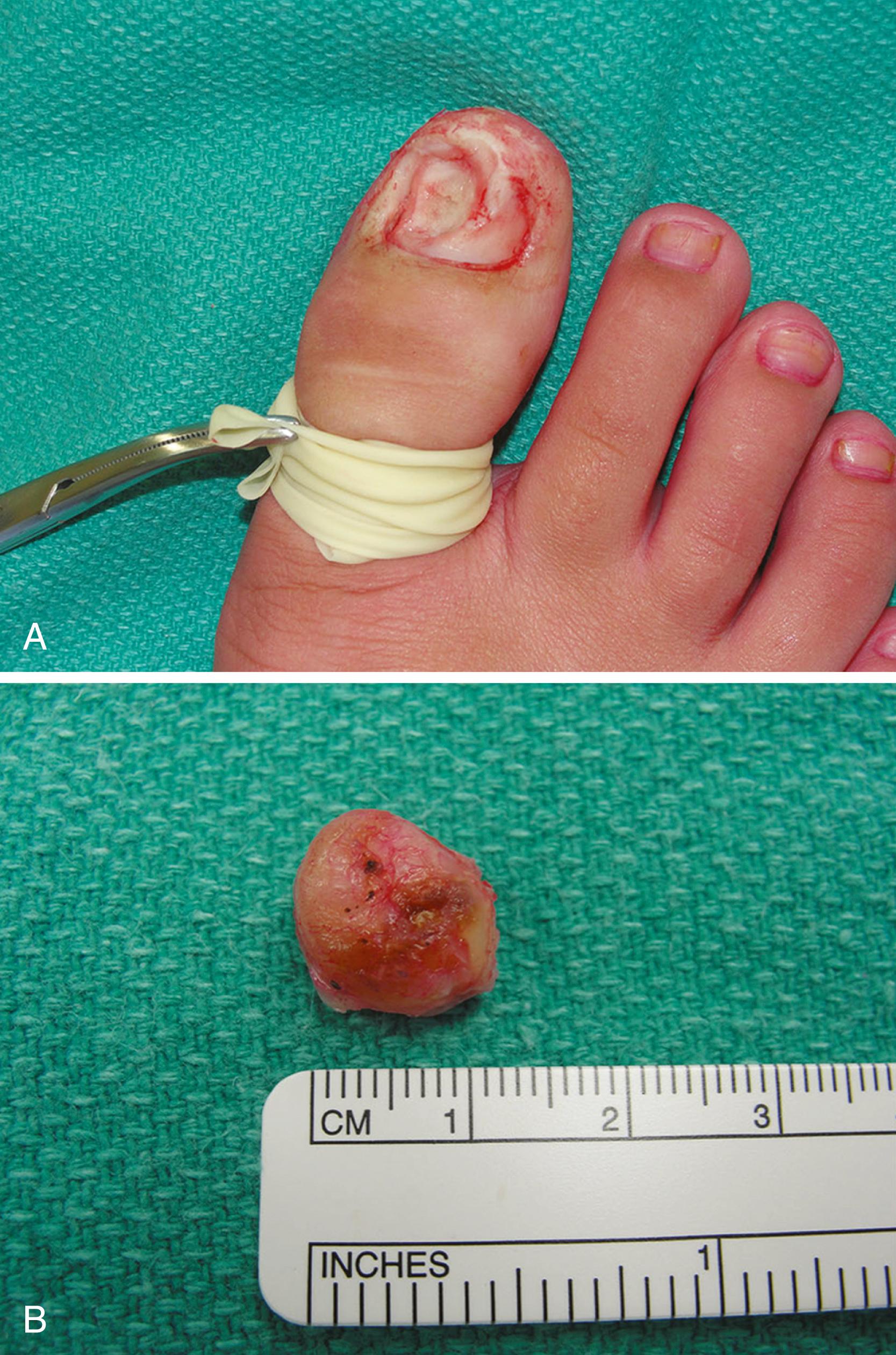
(Lokiec et al.)
After the administration of general anesthesia (young children) or ankle block (adolescents), apply a toe or ankle tourniquet.
Remove a narrow strip of nail (less than one fourth of the nail width) on the medial side of the toe ( Fig. 88.6A ) to expose the exostosis.

Carefully dislodge part of the remaining nail from its proximal attachments at the larger side of the exostosis, leaving the remainder of the nail in place, to fully expose the exostosis abutting and penetrating the nail bed.
Make a small osteotomy paralleling the distal phalanx to remove the exostosis in one piece ( Fig. 88.6B ).
Use a fine rongeur or a burr to produce a smooth surface and remove any residual osteochondroma tissue.
Irrigate the wound with saline, relocate the elevated nail and suture the nail fold with two small absorbable stitches ( Fig. 88.6C ) to cover the raw bone of the phalanx.
The nonadhesive dressings are changed every 3 days during the next 3 weeks. At 3 weeks, the sutures are removed and gradual return to normal-width shoes is allowed.
(Multhopp-Stephens and Walling)
Expose the lesion by removing a portion of the nail, or the entire nail if necessary ( Fig. 88.7A and B ).
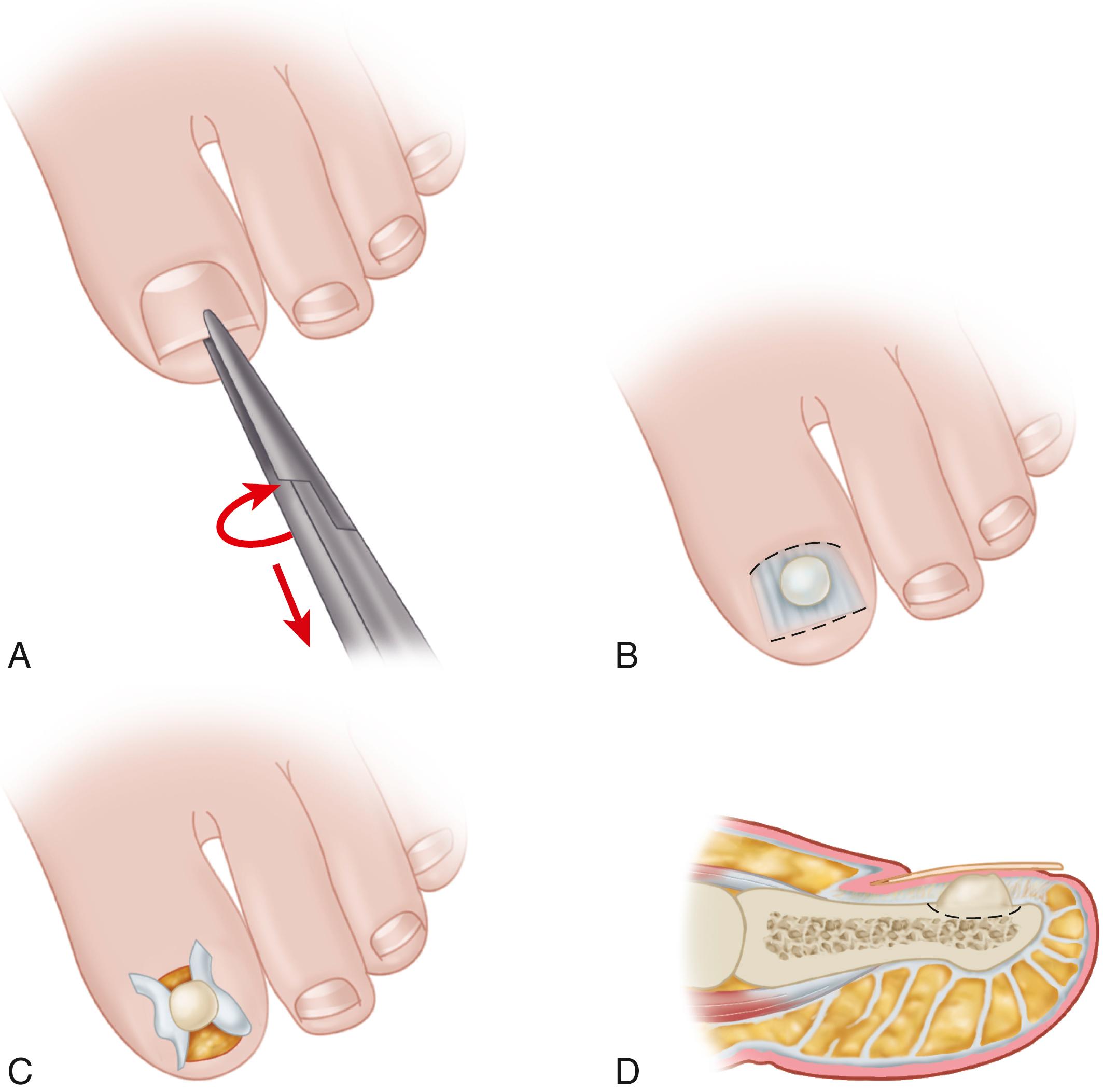
Ellipse the exostosis and carry dissection down to the phalanx where the stalk or base is attached. Do not try to preserve the overlying nail bed ( Fig. 88.7C ).
Remove the exostosis, including the cartilaginous cap and the overlying nail bed at its base from the distal phalanx.
Use a small burr to remove 1 to 2 mm of normal bone at the base of the lesion and smooth the contour of the distal phalanx ( Fig. 88.7D ).
Place an Adaptic, nonstick dressing beneath the nail fold.
Allow the defect to granulate and heal secondarily.
Patients are placed in a postoperative shoe and allowed to bear weight as tolerated.
Subungual and periungual fibromas can be most difficult to diagnose preoperatively. A history of long-standing symptoms, several physicians having seen the patient, local tenderness beneath a particular portion of the nail, and a frustrated patient all reinforce the suspicion of this diagnosis. If the mass is readily seen, as it occasionally is, the diagnosis is straightforward. A high index of suspicion for this rare tumor is warranted in patients with tuberous sclerosis because up to 80% may have ungual fibromas ( Fig. 88.8 ).
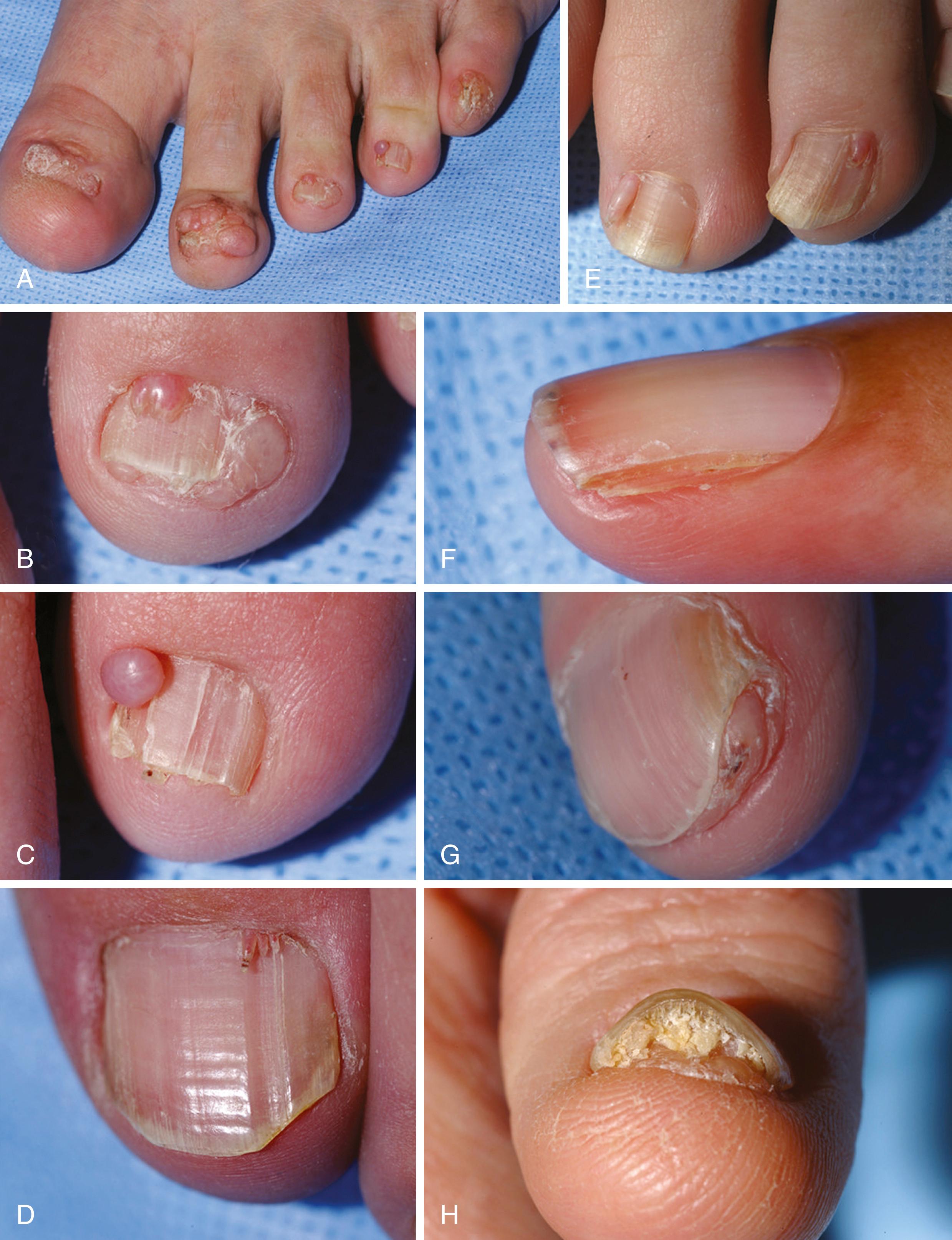
If the mass is beneath the nail, remove the portion overlying the area of tenderness.
Magnification and high-intensity lighting are helpful for locating a small, pearly whitish change in color compared with the surrounding matrix. Excise this portion down to the phalanx with a small margin of what appears as normal matrix and then section the tissue. It has a gritty feel when sectioned.
Send the specimens to pathology with the suspected diagnosis.
The postoperative care is the same as after incomplete matrixectomy, and permanent deformity of the nail may occur. This is less likely, however, than after removal of a large subungual exostosis.
The glomus tumor is an enigmatic, painful tumor that is rarely seen and represents a proliferation of the normal capsular-neural glomus apparatus. Patients commonly present with a painful, exquisitely tender mass beneath the nail that is accompanied by a faint bluish hue. Except for the slight change in color of the nail overlying the tumor, the nail may appear normal. The nail is normal, and the mass seen through the nail plate is abnormal. Radiographs may reveal a semi-spherical cortical lesion that, when present, is pathognomonic for a glomus tumor ( Fig. 88.9 ).

Removal of the portion of the nail plate over the area of tenderness and excision of the matrix that appears involved, along with a margin of normal-appearing matrix, is the treatment of choice. The nail that returns should have a normal appearance, but the patient must be warned that this is unpredictable. Magnification and high-intensity lighting facilitate excision of these periungual and subungual masses.
Horst and Nunley described a technique for removal of glomus tumors that uses a full-thickness vascular skin flap to expose the tumor while preserving the nail and nail matrix. They reported complete relief of pain, no wound healing problems, and no recurrences in seven patients in whom this technique was used.
Become a Clinical Tree membership for Full access and enjoy Unlimited articles
If you are a member. Log in here